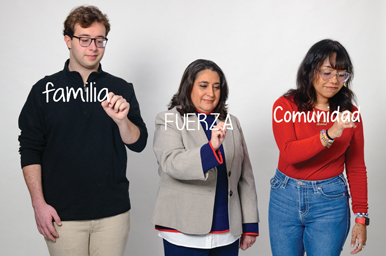
AU’s Heritage Spanish Program, one of only a few offerings of its kind at universities across the US, is more than a class—it’s a community.
Nicholas Caraballo, SPA/BA ’23, MPA ’25, president of the AU League of United Latin American Citizens (pictured left) grew up in Ohio speaking primarily English. He enrolled in Heritage Spanish I, offered by AU’s Department of World Languages and Cultures, in 2021 to learn to communicate more comfortably with his family in Puerto Rico.
“It’s a space to be ourselves,” Caraballo says of the program. “Latinos are not a monolith—that’s something we started with up front—but there are some shared experiences, especially language, that we all relate to. It made me feel like I’m not alone.”
According to a September 2023 report from the Pew Research Center, 75 percent of US Latinos can carry on a conversation in Spanish “pretty or very well.” However, 54 percent of non-Spanish-speaking Hispanics—including nearly 6 in 10 people with some college experience—have been shamed by others in their community for not speaking the language.
Now in its 10th year, AU’s Heritage Spanish Program has helped 255 undergraduates develop multilingual and multicultural literacy using heritage language, a nondominant tongue that’s often spoken at home.
While students who have grown up speaking both Spanish and English frequently have linguistic, cognitive, and cultural advantages over monolingual speakers of either language, the group is often left in limbo—too advanced for introductory language courses but also not fluent. A heritage speaker, for example, might be able to converse in Spanish but not write in it.
“[These speakers] are never really placed in courses where they are the protagonist of the curriculum,” says Lilian Baeza-Mendoza, program director (pictured center). “Instead of placing them in traditional courses, we created a series of four courses tailored to them, their needs, and their talents.”
Baeza-Mendoza described the program—which strengthens formal grammar and vocabulary, reading, and writing and improves speaking—as a public service to Eagles, who learn from and with one another. Students who identify as heritage speakers can take courses to meet their foreign language requirement or to brush up on their skills for academic and professional use. Forty-two students participated in the program during 2023–24.
Caraballo said the heritage courses marked the first time he’d been taught by a native speaker. That instruction boosted both his competency and his confidence in reading, writing, and speaking in Spanish.
The courses also helped him get to know his family on a deeper level. In his final course, Writing Across Our Cultures, Caraballo interviewed his grandmother in Puerto Rico. “I learned more about my family through that experience than I would have otherwise,” he says. “Those aren’t really questions you sit down and have a conversation [about] naturally. It’s a beautiful memory.”
For Alondra Aguilar, CAS-SOC/BA ’26, who grew up in Mexico and attended high school in Texas, AU’s heritage Spanish courses were beneficial for a different reason.
“Coming to Washington, DC, was a drastic change,” she says. Aguilar (pictured right) speaks Spanish as her first language and struggled to build community until she met Eagles with shared experiences.
Aguilar moved to the United States as a teenager and taught herself English by watching YouTube videos from American vloggers documenting the high school experience. But while she was learning a new language in Texas, she missed out on Spanish writing and rhetoric lessons in Mexico. She enrolled in AU’s program during her first semester to bolster those skills and was delighted to discover a welcoming classroom environment where she could be herself.
“I was thinking I did not feel like I belong here,” Aguilar says. “The heritage courses gave me that home and community.”